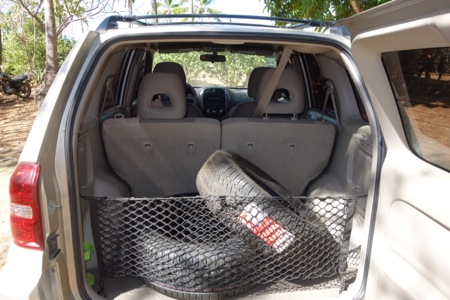Because of my ~0 experience buying cars, I hired my taxi driver to help me with the process. He found prospective deals, made appointments with owners, drove me to them, and then helped me evaluate the vehicles. The 2 most common models for sale that met my criteria were the Toyota RAV4 and the Daihatsu Terios Bego. Per BingoBoingo's advice I called local car rental companies to rent the models I was interested in for 1-2 days. Unfortunately they did not have them in stock. So I skipped the trial step and went straight to seeing the cars.
The first RAV4 looked promising from its advertisement. It was a 2002 model w/ 158,351 miles being sold for 4 million colones. It was owned by an older lady who lived in Santa Cruz. When we arrived to inspect the car I realized my first mistake, having worn a nice shirt. The next time I go used car shopping I'll be sure to wear ~rags; inspecting a car requires getting under it and getting dirty. Anyways, we found a problem that immediately rules out any car - an oil leak. As taxi amigo said, "la moto estaba llorando". We left immediately.
The next car we saw was a 2007 RAV4 with 144,310 miles. The car appeared to be in great condition. But its price was 6.8 million colones, a little on the high end of my budget, so we didn't inspect the vehicle thoroughly. Instead we told the owner we may come back after viewing a few more cars.
Then we went to a dealership. I had a sense of uneasiness there because of the unlevel playing field. The dealers are professionals at *selling* cars. Everything felt like a trap. The interiors of the cars, including the organs under their hoods, were squeaky clean and polished. And the dealership had all the lubricant ready to facilitate a quick purchase - a magic plastic acceptor and on premise lawyers. Regardless, I checked out a 2007 Honda CRV. This was the first vehicle I gave a test spin. As I was driving it, it had the tendancy to slightly veer off to the right. I had to keep a constant counter clockwise pressure on the steering wheel. I expressed my concern and I was told that the car just needs a realignment, a cheap procedure. The Honda was otherwise a nice car, but there were two key problems: its price and its mileage. With 213,000 miles at 6.5 million colones I was sure to realize a hefty loss when I tried to resell it.
I bought the fourth car I saw, a 2004 Toyota RAV4 w/ 148,636 miles for 4.5 million colones ($7,951):



Replacement front tires

Upon arrival we gave the car a visual inspection. The front tires were a bit worn but otherwise the vehicle looked good. I took it for a test drive. I had read reviews about the RAV4 that contained complaints about the engine's noise permeating through the car while driving. That seemed like the kind of thing that could annoy the hell out of me fast. But the engine sounded good / could hardly be heard from inside, and I found driving the car pleasant. After the test run I wanted to purchase the car.
I asked taxi amigo for his opinion. He said it was a good deal and if I liked the car I should negotiate and buy it. The car was being sold for 4.5 million colones. The result of my mediocore haggling was to get that price to include the lawyer fee and a set of new front tires.
I informed the owner that I wanted to have a mechanic inspect the car before I bought it. Since the car needed to get its Riteve in March I offerred to buy the car same day should the car pass the required inspection. So I drove for an hour with the owner to the Riteve office. Indeed, the inspection was thorough. The car passed so we drove to the lawyer's office.
The lawyer we chose was someone I had met a couple times already, my taxi driver's aunt. We ran into an issue because I was not able to do a same day wire into the owner's bank account. He agreed to sign over the car in exchange for a down payment of 900,000 colones cash, and my promise that I'd pay him as soon as the fiat systems acknowledged him as a wire recipient. Although the owner physically kept the car until he received all of the funds, my taxi amigo thought it was bold of him to sign over the ownership after only receiving a down payment and a promise. I think the enjoyable conversation I had with the owner on the car ride to the Riteve office built some trust. Two days later the money was in his account and the car was in my backyard.



